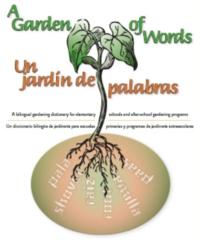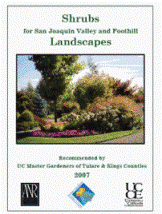|
The Master Gardeners offer free information on home gardening. Call the MG phone helpline during our office hours or leave an email or voice message after hours. Tulare County Email: You may fill out this survey Kings County Email: Website: |
Landscape Trees & Shrubs
Shrubs for San Joaquin Valley & Foothills
55 "tried & true" shrubs complete with photos, descriptions and growing tips.
Ornamental Tree Selection & Guide
(12 pages)
Learn how to:
- Select Trees for Your Property
- Choose Good Trees at the Nursery
- Consider Utilities When Planting Trees
- Plant and Stake Trees Properly
- Recognize Tree Disorders
- Train Young Trees for Structure and Form
- Prune Mature Trees
Complete Tree List for Home Gardens is Included.
Planting & Staking Tips (2 pages)
- A Quick How to Guide on Planting and Staking Young Trees
- Video: How to Prune Trees (19 min) - 5 step process is outlined and demonstrated. Very easy to follow and only simple tools are needed.
Tree Lists
Landscape Tree Care
TREE SELECTION
 |
Trees are a costly and major part of your landscape. Trees provide shade, privacy, and beauty but a tree in the wrong place can become an expensive problem in years to come. The ultimate size and shape of the mature tree, how much annual maintenance it will require, the location in your yard, and the purpose you intend are among the many considerations when selecting a tree. Many species deciduous and evergreen, with a wide variety of characteristics are suitable for our area.
Suggested Trees for Small Spaces
Tree Selection Poster
SELECTING QUALITY TREES
Nursery tree selection is one of the most important investment decisions a homeowner can make. Healthy trees make our environment more pleasant and increase the value of our real estate. A large shade tree can also provide relief from the summer's heat and reduce summer cooling costs. To make a successful tree selection, choose the "right tree for the right space". High quality trees have certain characteristics that are worth knowing when you head to the nursery to purchase your tree.
 |
PROPER PLANTING
A healthy tree begins with correct planting procedures. To avoid poor growth or death of a young tree, it is wise to invest some time to learn the right way to plant a tree. Proper planting techniques are not difficult to master, and a well-planted tree will grow and prosper more rapidly. Newly planted trees are more likely to survive and prosper if mulched. Landscape trees which are planted in or near lawns require special treatment.
 |
PROPER STAKING
Some young trees need support during their first years of growth, and this is supplied by staking the tree. How a tree is staked affects the tree trunk's strength and shape. Improper staking can do more harm than good. A badly staked tree may be injured by the stakes or ties and fail to develop a strong, straight trunk. See trees and turf section below.
 |
TRAINING YOUNG TREES FOR STRUCTURE AND FORM
Training and caring for young trees is, in some ways, a lot like raising children. Give them care and attention, a little discipline and consistent structure in the early years and there will be fewer problems later on. Trained trees are structurally stronger, less likely to break apart in a storm, and require less maintenance. Well trained trees will not have to be removed because they are too large for the space, drop leaves into the neighbor's pool, or their unbalanced limbs pose a hazard.
PRUNING MATURE LANDSCAPE TREES
 |
Landscape trees that are carefully selected and properly planted, trained and maintained should require little pruning after they reach maturity. Such trees require only the removal of poorly positioned or strongly competing limbs, weak branch attachments, or branches that are damaged or dead. Mature trees should be inspected annually to assess overall structure and to determine if any limbs should be removed. Trees with dense foliage may benefit from some crown thinning to improve light penetration and air movement. Improper pruning can lead to various future problems, increased cost and hazards. As well-pruned tree, best done by a certified arborist , should look as if it has not been pruned.
PESTS AND DISEASES
 |
Most landscape trees can be kept healthy and protected from pests and diseases by good cultural practices. Some problems are 'abiotic' , such as cold or heat injury, hail damage, drought stress or mechanical injury. These must be distinguished from 'biotic' maladies which are caused by insects, microorganisms or other living pests. Proper diagnosis is the first step to solving the problem and to identify the pest. When pesticide use is called for, the least toxic effective material should be selected. Treatment is necessary only when the pest population reaches a certain threshold. Strict attention also should be paid to the safe handling, storage and disposal of all pesticides.
TREES AND UTILITIES
 |
We have all seen trees under power lines that have a big "V" taken out of the crown to make room for the power lines. To avoid unsightly trees and conflicts with utilities, proper tree selection and placement around utilities will eliminate safety hazards, reduce expenses for utilities and their rate payers, and improve the appearance of a landscape. Underground utilities should be located prior to planting. Underground Service Alert (1-800-227-2600) offers free, simple help and ensures the safety of the utility worker and homeowner while preventing damage to or interruption of utility services.
TREES AND TURF
Extra attention must be paid to plant selection, placement, and soil where trees and turf are grown in the same area. Some trees are better companion plants for turf than others. Dense tree canopies cause the turf under trees to be sparse and unhealthy. Trees should have an open or high canopy that allows sunlight to penetrate to the ground. All trees planted in lawns should be surrounded by a 6-foot diameter plant-free zone. This zone should be covered with 2-4 inches of mulch to help retain soil moisture, reduce weeds and protect the tree trunk from trimmer and mower damage.
Turf and trees require different irrigation. Turf does best with frequent short watering schedules, whereas trees need infrequent, deep irrigation. Deeper, less frequent watering of trees will encourage deeper root systems and will lessen the tendency to grow roots near the soil surface. Avoid trees with a tendency to produce shallow roots.
OAKS
Oaks are frequently included in California landscapes, though many gardeners are unaware that they may require special treatment in order to thrive. Some oaks, particularly native California species, are not well adapted to the home garden environment and may succumb to soil-borne diseases that can be avoided with proper management techniques. Special care is needed when building around oak trees if the trees are to survive. Strangely-shaped and often colorful galls are often observed on the leaves, twigs and branches of many oak species-fascinating but harmless.
PLANTING UNDER NATIVE OAKS
In general nothing should be planted within a 10 foot radius of the trunk of a native oak. Do not irrigate, plant or disturb the soil in this area. Organic mulches at least 2 inches thick are very beneficial in this zone, and can look quite attractive. Generally, native oaks do not require irrigation. In case of severe drought, or root loss due to construction or transplanting, use drip irrigation only at and beyond the outer edge of the tree canopy. Never use a sprinkler system and do not wet the trunk to reduce the risk of root rot. Native oaks do not require fertilizer. Do not compact the soil, change the drainage patterns, raise or lower the soil grade, trench or cut roots or use a rototiller near native oaks. If paving is required, use porous paving, such as brick on sand or gravel, and sweep it during the summer months. Do not hose off. If landscaping is necessary, use drought tolerant native plants. Plant only outside or beyond the 10-foot area around the trunk. Bulbs and wildflowers, which do not require summer watering, can be used.
Suggested Plants Compatible with Oaks
SHOPPER'S GUIDE TO LANDSCAPE TREES
Shoppers Guide to Deciduous Trees
Shoppers Guide to Evergreen Trees
Additional Landscape Tree Resources:
Harris, R.W. et al, Arboriculture: Integrated Management of Landscape Trees, Shrubs, and Vines (3rd edition)
Tree Selection for Landscapes - University of Florida


